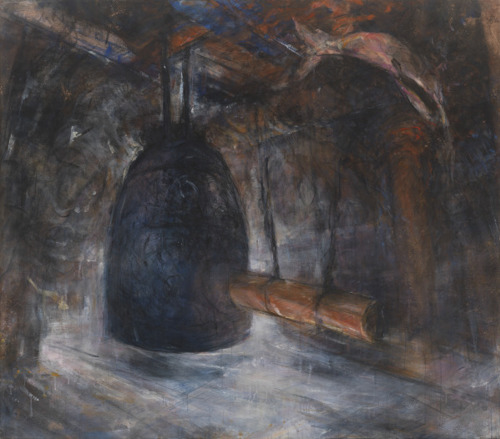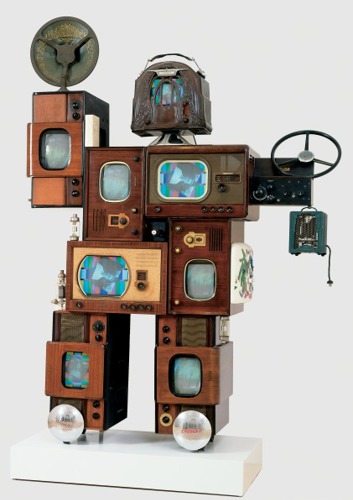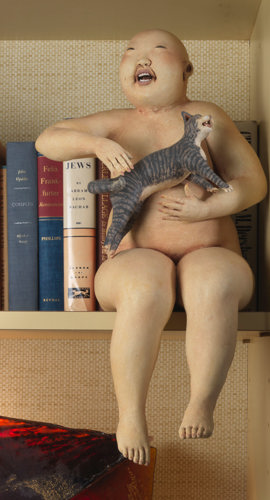Celebrating Asian American Pacific Islander Heritage Month
by Cincinnati Art Museum
5/3/2022
In honor of Asian American Pacific Islander (AAPI) Heritage Month this May, the Cincinnati Art Museum is continuing to recognize and appreciate the immense role Asian peoples and cultures have in our collection, and the fundamental human right of Asian Americans to the pursuit of life, liberty, and happiness in Greater Cincinnati and across the world.
Enjoy these works in the museum’s permanent collection by artists who identify as Asian American or Pacific Islander.
Bukang Y. Kim (b. 1943)
Bukang Kim is a Korean-born American artist based in Cincinnati, Ohio. She received her early training at Seoul National University and, after coming to the United States in 1970, furthered her study at the University of Cincinnati. Her paintings and drawings are widely exhibited in South Korea, Europe, and the United States. In 2014, the Cincinnati Art Museum hosted the special exhibition Bukang Y. Kim: Journey, highlighting Kim’s artistic journey of over thirty years.
The path Kim has traveled in developing her artistic style is long and inspirational. Her migration to the United States led her to develop a new sensitivity to the arts and cultures of her Korean homeland and helped provide her with a completely new cultural identity, reshaping both her technical and spiritual artistic perspective. Memories from the past, such as the resounding ring of the temple bell in the mountains (Image 1), the ancient wood columns (Image 2), or the paper-mounted sliding doors in the traditional Korean house (Image 3), evoke not only strong emotions associated with her home country but also a new interpretation of the Asian philosophies and cosmological concepts (the Daoist duality of the universe: yin/yang, sound/silence, solid/void, within/without, light/dark) so familiar to her. Her western-based training, combined with her deep understanding of Asian aesthetics and strong discipline in Asian calligraphy, has helped her create a powerful and distinctive pictorial language all her own.

Bukang Y. Kim, (Korean American, b. 1943), The Bell, 1988, acrylic on canvas, 84 x 96 in. (213.4 x 243.8 cm), Gift of Bukang Yu Kim and Dr. Young Ghon Kim, 2019.291

Bukang Y. Kim, (Korean American, b. 1943), Column, 1988, mixed media on canvas, 84 x 66 in. (213.4 x 167.6 cm), Gift of Bukang Yu Kim and Dr. Young Ghon Kim, and family, 2015.140. This artwork is currently on view in Gallery 124.

Bukang Y. Kim, (Korean American, b. 1943), Morning Calm, 1988, mixed media on canvas, 84 x 66 in. (213.4 x 167.6 cm), Gift of Bukang Yu Kim and Dr. Young Ghon Kim, and family, 2015.139
Yasuo Kuniyoshi (1893–1953)
In Daily News, a half-dressed woman, smoking a cigarette and supporting her chin with her hand, seems pensive or bored. A man’s fedora hat suggestively appears on the radiator behind her. Always a subtle colorist, Yasuo Kuniyoshi became newly concerned in the late 1930s with the manipulation of paint. The background of swirling brushstrokes and scratches made with the back end of the brush echoes the curlicues of the cast iron stool and the radiator design.
Kuniyoshi was born in Okayama, Japan, and arrived in the United States in 1906. He studied art with Robert Henri and Kenneth Hayes Miller, both of whom championed subjects from American life. Kuniyoshi initially went his own way, earning fame in the 1920s for fantasy subjects depicted in a deliberately primitive style. But in his work of the 1930s, he responded to the call for paintings of the “American Scene” with a turn to greater naturalism.

Yasuo Kuniyoshi (American, b. Japan, 1893–1953), Daily News, 1935, oil on canvas, The Edwin and Virginia Irwin Memorial, 1959.48. Art © Estate of Yasuo Kuniyoshi, VAGA at Artists Rights Society (ARS), NY
Nam June Paik (1932–2006)
When approached by the Cincinnati Art Museum to create a piece specific to Cincinnati, Nam June Paik suggested a video sculpture to honor Powel Crosley, Jr., the Cincinnati inventor, and entrepreneur. At that time, Paik, who exhibited internationally, assembled all his sculptures, including Powel Crosley, Jr., in a warehouse in the Cincinnati neighborhood of Over the Rhine.
The work consists of various Crosley products: TV and radio cabinets, car hubcaps and handles, radios, freezer doors, and radio transmission tubes. The boxy-looking “portrait” is related to a family of human-looking robots that Paik created in 1986. In the Crosley sculpture, he used eight television monitors to project two different programs. These programs loop clips from a television profile of Crosley Paik intercut with popular imagery, which flash on the screens at a hypnotizing pace. In contrasting the antiquated Crosley parts with contemporary digital media, Paik made an oblique comment on technological evolution.
Crosley was born in Cincinnati in 1886. After working first in advertising and auto-building, he brought the new technology of radio to millions through build-it-yourself kits. Crosley also founded radio station WLW and public television WCET, made the first car radio, built the first compact car, and owned the Cincinnati Red Stocking baseball team.
Paik, born in Korea, studied music and art history in Tokyo. In 1958 he met the composer John Cage, who became a lasting influence on him. In the 1960s, Paik became fascinated with television and video. He exploited the medium to assert his belief that the human spirit is ascendant over technology, no matter how.

Powel Crosley, Jr., Nam June Paik (American, b. Korea, 1932–2006), artist, 1992, wood, plastic, paint, glass, custom electronics, parts from a variety of Crosley products that date from the 1920s through the early 1950s, eight CRT televisions, two DVD players, video, John J. Emery Endowment and The Edwin and Virginia Irwin Memorial, © Nam June Paik Estate, 1992.140
Esther Shimazu (b. 1957)
The nude, bald figures created by Esther Shimazu, a third-generation Japanese-American, are meant to encapsulate the state of unselfconsciousness–the attitude of being care- and judgement-free. Shimazu often pairs her people with animals, like this leaping housecat, the embody her ideas about freedom and defiance.

Leaping Tabby, 2002, Esther Shimazu (American, born 1957), stoneware, The Nancy and David Wolf Collection, 2011.139 © Esther Shimazu
Kataro Shirayamadani (1865–1948)
In 1895, the Rookwood Pottery Company began experiments to achieve the challenging technical feat of using the color black in its Iris glaze line. Their experiments succeeded, and in 1899 Rookwood launched the Black Iris glaze line, which featured natural-colored decorations, usually flora, on black backgrounds.
Japanese-born Kitaro Shirayamadani, Rookwood’s most accomplished decorator, designed and created this masterpiece in the pottery’s new line. It features birds flying above masterfully carved silver and copper water lilies, all against a black night sky. The complex technique of adding metallic decoration to clay via electrodeposit had been developed by Shirayamadani earlier that year, but Rookwood soon discontinued its application due to high production costs.
This Vase, because of its date, its size, its use of the electrodeposited metal technique, its glaze line, its decorator, and its quality, was almost certainly one of the works displayed at the Exposition Universelle of 1900 in Paris, where Rookwood received the grand prize–the fair’s highest honor.
Shirayamadani continued to work for Rookwood until his death in 1948.

Vase, 1900, The Rookwood Pottery Company (American, est. 1880), Kitaro Shirayamadani (American, b. Japan, 1865–1948), decorator, stoneware, Black Iris glaze line with copper and silver electrodeposits, Museum Purchase: Lawrence Archer Wachs Fund and a generous gift from Judge and Mrs. Norman A. Murdock, 2004.68. This artwork is currently on view in Gallery 114.
Explore more works by Asian American or Pacific Islanders in the museum’s collection with this self-guided tour through our galleries and while exploring online.






